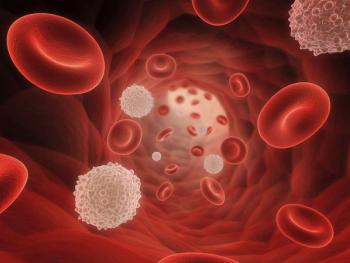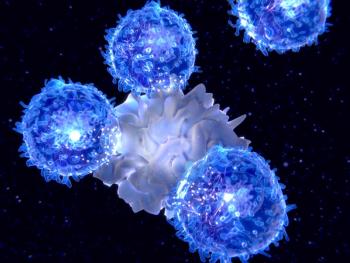
Oncology NEWS International
- Oncology NEWS International Vol 11 No 2
- Volume 11
- Issue 2
Chemotherapy Plus Radioimmunotherapy Increases Response in Follicular NHL
ORLANDO, Florida-Conventional chemotherapy has limited efficacy against follicular non-Hodgkin’s lymphoma (NHL), but research reported at the 43rd Annual Meeting of the American Society of Hematology showed promising results when conventional regimens were combined with the anti-CD20 drug tositumomab/I-131 tositumomab (Bexxar).
ORLANDO, Florida-Conventional chemotherapy has limited efficacy against follicular non-Hodgkin’s lymphoma (NHL), but research reported at the 43rd Annual Meeting of the American Society of Hematology showed promising results when conventional regimens were combined with the anti-CD20 drug tositumomab/I-131 tositumomab (Bexxar).
Oliver W. Press, MD, reported for the Southwest Oncology Group on SWOG-9911, a phase II trial of CHOP (cyclophosphamide [Cytoxan, Neosar], doxorubicin HCl, vincristine [Oncovin], prednisone) followed by tositumomab/I-131 tositumomab for newly diagnosed follicular non-Hodgkin’s lymphomas. John P. Leonard, MD, reported a trial of fludarabine (Fludara) followed by tositumomab/I-131 tositumomab for follicular low-grade lymphoma.
CHOP Followed by Radioimmunotherapy
"Advanced follicular lymphomas are incurable with conventional chemotherapy regimens. Standard chemotherapy and radiolabeled antibodies each cause remission but are not curative, so we decided to try combining these modalities," Dr. Press said. He is professor of medicine in the Department of Medical Oncology at the University of Washington in Seattle.
Patients were treated with six cycles of standard CHOP chemotherapy (cyclophosphamide at 750 mg/m², doxorubicin at 50 mg/m², vincristine at 1.4 mg/m², and prednisone at 100 mg orally for 5 days) given at 3-week intervals followed by radioimmunotherapy. Four weeks after the completion of the last cycle of CHOP, patients with either a partial (PR) or complete remission (CR) underwent dosimetry with 450 mg of unlabeled tositumomab and 35 mg of trace-labeled I-131 tositumomab. Based on the rate of clearance of this dosimetric infusion, the subjects were treated with tositumomab labeled with 48 to 115 mCi of I-131 (median: 84 mCi), estimated to deliver 75 cGy to the whole body. This therapeutic dose was administered 1 to 2 weeks after the trace-labeled dose.
Toxicity and Response Data
Dr. Press said that 102 patients with newly diagnosed follicular lymphomas (grade 1, 2, or 3) were registered, of whom 92 were eligible for treatment. Eighty-eight patients were evaluable for toxicity from the CHOP regimen; 60 patients were evaluable for toxicity from I-131 tositumomab. This included grade 3 or 4 neutropenia in 52% of patients after CHOP and 15% of patients after I-131 tositumomab; thrombocytopenia in 1% and 15%; and febrile neutropenia in 7% and 3%.
Dr. Press reported response data on 71 patients, which showed that adding the radiolabeled antibody to CHOP increased both overall and complete responses (see Table 1). He said that 1-year failure-free survival was 92%, and 1-year overall survival was 99%. This study is being followed by SWOG 0016, which will compare the efficacy of CHOP, CHOP plus rituximab, and CHOP plus I-131 tositumomab in a randomized trial.
Fludarabine Followed by Radioimmunotherapy
John P. Leonard, MD, said that fludarabine was added to I-131 tositumomab in his study to improve activity in bulky disease. He is medical director of the Center for Lymphoma and Myeloma at Cornell University’s Weill Medical College in New York.
Patients were treated with a sequential regimen of three cycles of fludarabine (25 mg/m² × 5 days every 5 weeks) followed 6 to 8 weeks later by I-131 tositumomab.
Response Data
Thirty-eight patients with previously untreated follicular low-grade NHL were enrolled, and 35 patients completed both fludarabine and I-131 tositumomab therapy and were evaluable for response. Three percent of patients had stage III, 23% stage III, and 26% stage IV disease. "Most had two or more sites of disease," Dr. Leonard said. "Sixty percent had tumors larger than 5 cm."
The response rate was 100%, including 71% confirmed CR. "The majority of patients had PR after fludarabine, and we saw a conversion to predominantly CR after I-131 tositumomab," Dr. Leonard said.
Median progression-free survival has not been reached after a median 27 months of follow-up. Of 12 patients who were PCR positive for bcl-2 gene rearrangements in bone marrow at baseline and who had samples reassessed at 12 months posttherapy, 10 became PCR negative. Only 6% of patients developed human antimouse antibodies (HAMA).
"Sequential therapy with fludarabine followed by I-131 tositumomab is highly effective as up-front therapy for follicular low-grade NHL, with durable remissions, acceptable toxicity, and minimal HAMA formation. Fludarabine induction therapy cytoreduces bone marrow involvement of lymphoma and suppresses HAMA," Dr. Leonard said.
Articles in this issue
almost 24 years ago
R115777 Has Significant Activity in CML and Myelofibrosisalmost 24 years ago
National Cancer Prevention Campaign Discussedalmost 24 years ago
CHOP Plus Rituxan Proves Cost-Effective in B-Cell Lymphomaalmost 24 years ago
Lung Cancer Screening Protocol Moves Forwardalmost 24 years ago
Cancer Prevention Research Hampered by Lack of Biomarkersalmost 24 years ago
Rituximab Improves Efficacy of Chemotherapy for Follicular Lymphomasalmost 24 years ago
Long Survival Confirmed in CML Patients Who Respond to InterferonNewsletter
Stay up to date on recent advances in the multidisciplinary approach to cancer.
















































































